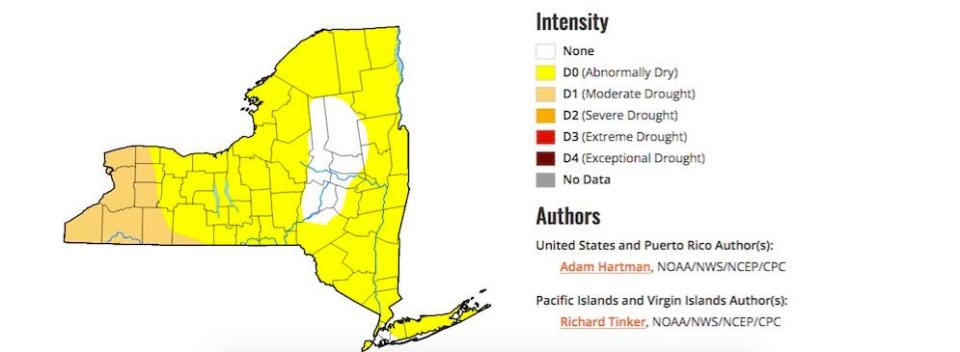It's finally raining in the Southern Tier. Is it enough to ward off drought conditions?
Jessica Hoffman didn't hold back. When significant rain fell for the first time in more than a month at Sunset View Creamery in the Schuyler County town of Odessa on June 8 she took to her farm's Facebook page to share the good news.
"We're getting measurable rain!!!" she wrote. "42 days we have been without. Hallelujah."
Raindrops have been falling across the Southern Tier of New York during the first weeks of June, but whether recent bouts of precipitation will be enough to pull the region out of drought threats following May's record shortfall remains unknown.
Last month was one for the record books in Binghamton and the Southern Tier.
Consider: Nearly an inch of rain, 0.91, fell on June 9 around Binghamton, according to the National Weather Service. That was more in one day than the entire previous month's total.
In fact, in more than 70 years of keeping rainfall numbers, the National Weather Service Office in Binghamton had never recorded a drier May than May 2023.

Figures tell part of the story:
The National Weather Service reported 0.71 inches of rainfall in the Binghamton area during May — the lowest for any May since records began in 1951. The average May rainfall for Binghamton is nearly four inches.
Nearly half of May's rainfall took place on the first day of the month, May 1, when 0.31 inches were tallied.
After 0.13 inches of rain was recorded on May 7, the Binghamton area did not receive another drop until a tiny fraction, 0.04, was recorded on May 20.
No rain was detected for the rest of the month at the Binghamton National Weather Service measuring station.
In the Western New York Region, Buffalo received 1.15 inches of rain in May, more than two inches below normal for the month, while Rochester's rainfall was 1.4 inches for the month, about 1.5 inches below normal.
Why it was so dry in May
Ted Champney, a meteorologist with the Binghamton National Weather Service Office, attributed the dry month to a "blocking pattern," explaining, "The storms were kept to the Midwest and also further east of us. We did not have many cold fronts go through during the month of May that resulted in rain."
Champney added, "It’s not unusual but it’s not common.”
For much of Western New York, heavy snowfall earlier in the year gave the region some buffer room.
“We have been above average for precipitation and once we got through May, we are right on average for a yearly total," explained Buffalo-based National Weather Service meteorologist Heather Kenyon. “The rain we have seen the last few days has helped."
The National Weather Service's Climate Prediction Center is forecasting a mixed outlook for the upcoming summer months. Despite recent rains, the forecast for June is for conditions to be slightly warmer and dryer than normal.
The three-month outlook for rainfall shows a better chance for above normal participation, according to the Climate Prediction Center, but Champney cautioned, “On the flip side, there will be more evaporation because there is a better chance that it will be warmer than normal."

U.S. Drought Monitor: Most of New York state 'abnormally dry'
In its most recent update on June 15, the U.S. Drought Monitor classified nearly all of New York state, including every Southern Tier county, as at least "abnormally dry" — the mildest category of drought.
However, conditions are worse in the western Southern Tier, with the southern section of Steuben County and nearly 90% of Allegany County in "moderate drought," according to the federal agency.
In addition to stunted crop growth, moderate drought conditions can result in lower surface water levels, elevated risk for wildfires, increased stress on trees and landscaping and even a decline in honey production, the U.S. Drought Monitor cautioned.
"We are in summer now, farmers have done a first (hay) cutting. Some of those fields have not come back yet because they have not had the rain," Champney said. “We are in a short term water deficit, but that can turn around quickly if we get more rain."
A trip around the region shows some residential yards that appear to be withering, like during the "dog days" of summer.
“Some of the lawns here in the Binghamton area are brown, which is really strange for this early in the year when that’s normal towards August when we have more heat," Champney said.
More: 'Chill out with the cows': Schuyler County farm innovates with 'cow cuddling' venture
'The rain came when it should'
At Sunset View Creamery, Hoffman is a glass-half-full type of farmer, preferring to look at the positives after a very worrisome dry spell.
The first cut of hay went well and the dry conditions were fine for planting, she said.
And then, the few drops that fell during the 42-day period were just enough to “knock the dust out of the air.”
“Corn all around here was in four leaf stage but it was starting to wilt just a little bit," she said. "The rain came just at the perfect time, basically. The rain came when it should, so I can’t complain.”
Follow Neal Simon on Twitter @HornellTribNeal. To get unlimited access to the latest news, please subscribe or activate your digital account today.
This article originally appeared on Binghamton Press & Sun-Bulletin: Binghamton had driest May on record in 2023, drought risk lingers

